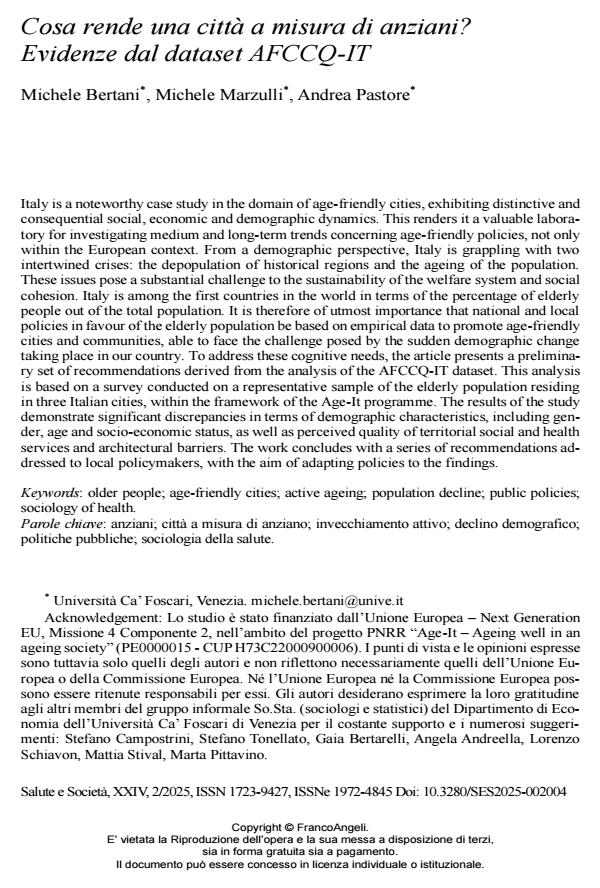Cosa rende una città a misura di anziani? Evidenze dal dataset AFCCQ-IT
Titolo Rivista SALUTE E SOCIETÀ
Autori/Curatori Michele Bertani, Michele Marzulli, Andrea Pastore
Anno di pubblicazione 2025 Fascicolo 2025/2
Lingua Italiano Numero pagine 13 P. 36-48 Dimensione file 396 KB
DOI 10.3280/SES2025-002004
Il DOI è il codice a barre della proprietà intellettuale: per saperne di più
clicca qui
Qui sotto puoi vedere in anteprima la prima pagina di questo articolo.
Se questo articolo ti interessa, lo puoi acquistare (e scaricare in formato pdf) seguendo le facili indicazioni per acquistare il download credit. Acquista Download Credits per scaricare questo Articolo in formato PDF

FrancoAngeli è membro della Publishers International Linking Association, Inc (PILA)associazione indipendente e non profit per facilitare (attraverso i servizi tecnologici implementati da CrossRef.org) l’accesso degli studiosi ai contenuti digitali nelle pubblicazioni professionali e scientifiche
Italy is a noteworthy case study in the domain of age-friendly cities, exhibiting distinctive and consequential social, economic and demographic dynamics. This renders it a valuable labora-tory for investigating medium and long-term trends concerning age-friendly policies, not only within the European context. From a demographic perspective, Italy is grappling with two intertwined crises: the depopulation of historical regions and the ageing of the population. These issues pose a substantial challenge to the sustainability of the welfare system and social cohesion. Italy is among the first countries in the world in terms of the percentage of elderly people out of the total population. It is therefore of utmost importance that national and local policies in favour of the elderly population be based on empirical data to promote age-friendly cities and communities, able to face the challenge posed by the sudden demographic change taking place in our country. To address these cognitive needs, the article presents a prelimina-ry set of recommendations derived from the analysis of the AFCCQ-IT dataset. This analysis is based on a survey conducted on a representative sample of the elderly population residing in three Italian cities, within the framework of the Age-It programme. The results of the study demonstrate significant discrepancies in terms of demographic characteristics, including gen-der, age and socio-economic status, as well as perceived quality of territorial social and health services and architectural barriers. The work concludes with a series of recommendations addressed to local policymakers, with the aim of adapting policies to the findings.
Parole chiave:anziani; città a misura di anziano; invecchiamento attivo; declino demografico; politiche pubbliche; sociologia della salute.
- Accetturo A., Albanese G., Ballatore R. M., Ropele T., Sestito P. (2022). I divari territoriali in Italia tra crisi economiche, ripresa ed emergenza sanitaria. Banca d’Italia, Questioni di Economia e Finanza (Occasional Papers), N.685. -- Testo disponibile al sito: https://www.bancaditalia.it/pubblicazioni/qef/2022-0685/ (16/04/2025).
- Bertani M., van Hoof J., Dikken J. (Forthcoming). Getting older people’s voices heard: A quantitative study using the validated italian age-friendly cities and communities questionnaire in Venice, Verona and Palermo. Journal of Cross-Cultural Gerontology.
- Bertin G., Da Roit B., a cura di (2020). Long-term care: Strategie di sviluppo. Salute e Società, XIX, 3.
- Black K., Oh P. (2022). Assessing age-friendly community progress: What have we learned? The Gerontologist, 62(1): 6-17.
- Bramanti D., Donato S., a cura di (2024). La famiglia che invecchia. Vivere e accompagnare la transizione alla fragilità. Milano: Vita e Pensiero.
- Dalla Zuanna G., Micheli G.A., editors (2004). Strong family and low fertility: A paradox? New perspectives in interpreting contemporary family and reproductive behaviour (European studies of population, 14). Dordrecht: Kluwer Academic Publishers. DOI: 10.1007/1-4020-2837-
- Dikken J., van den Hoven R.F.M., van Staalduinen W.H., Hulsebosch-Janssen L.M.T., van Hoof J. (2020). How older people experience the age-friendliness of their city: Development of the age-friendly cities and communities questionnaire. International Journal of Environmental Research and Public Health, 17(18): 6867.
- European Commission (2023). Report on the quality of life in European cities. Testo disponibile al sito: https://ec.europa.eu/regional_policy/information-sources/maps/quality-of-life_en (16/04/2025).
- Greenfield E.A., Buffel T. (2022). Age-friendly cities and communities: Research to strengthen policy and practice. Journal of Aging & Social Policy, 34(2): 161-174. DOI: 10.1080/08959420.2022.204957
- Hiu-kwan Chui C., Lu S., Fung Chan O., Chun-Sing Cheung J., Guo Y., Liu Y., Wai Chan S., Yee Man Tang J., Au A., Wen Z.V., Yu R., Bai X., Joshua Mok K.O., Woo J., Lum T. (2022). Changes in older adults’ perceptions of age-friendliness in Hong Kong: A three-year mixed-methods study. Cities, 127: 103748.
- Istat (2025). Demografia in cifre. -- Disponibile al sito: https://demo.istat.it/ (16/04/2025).
- Luciano A., Pascale F., Polverino F. (2023). Italian age-friendly house scorecard (IAHS): A composite indicator for assessing housing’s age-friendliness. Journal of Aging and Environment, 39(1): 82–104. DOI: 10.1080/26892618.2023.227577
- United Nations (UN), Department of Economic and Social Affairs, Population Division (2018). The World’s Cities in 2018 – Data Booklet.
- van Hoof, J., van den Hoven, R.F.M., Hess, M., van Staalduinen, W.H., Hulsebosch-Janssen, L.M.T., Dikken, J. (2022). How older people experience the age-friendliness of The Hague: A quantitative study. Cities 124: 103568.
- van Hoof, J., van Staalduinen, W.H., Dikken, J. (2024). A multi-year quantitative study of the experienced age-friendliness in The Hague: A tale of four personas. Social Science & Medicine 340: 116362.
- Wong M., Chau Ph., Cheung F., Phillips D. R., Woo J. (2015), Comparing the age-friendliness of different neighbourhoods using district surveys: An example from Hong Kong. PLoS ONE, 10(7): e0131526.
- World Health Organization (WHO). (2007). Global age-friendly cities: A guide. Testo disponibile al sito: https://www.who.int/publications/i/item/9789241547307 (16/04/2025).
- World Health Organization (WHO) (2023). National programmes for age-friendly cities and communities: A guide. -- Testo disponibile al sito: https://www.who.int/publications/i/item/9789240068698 (07/03/2025).
Michele Bertani, Michele Marzulli, Andrea Pastore, Cosa rende una città a misura di anziani? Evidenze dal dataset AFCCQ-IT in "SALUTE E SOCIETÀ" 2/2025, pp 36-48, DOI: 10.3280/SES2025-002004